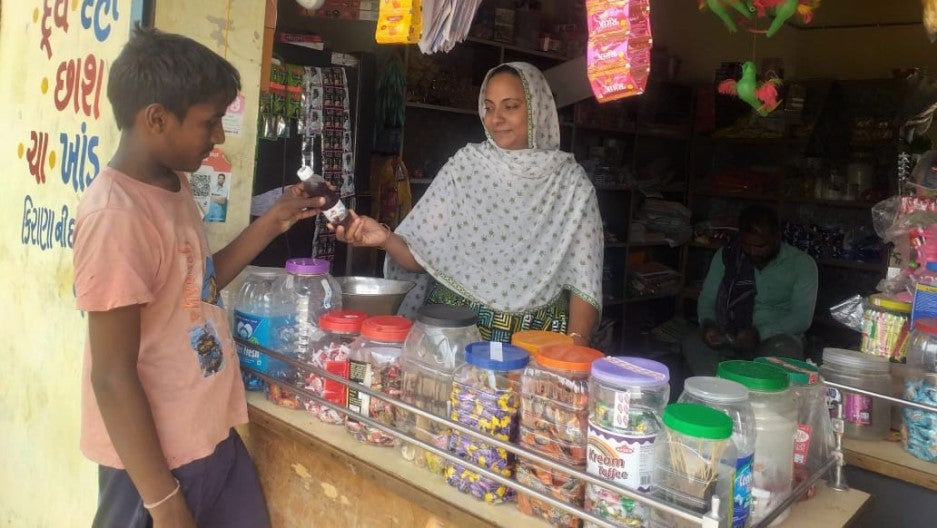 Many women entrepreneurs say that the new digital tools have made it easy for them to track their income and expenditure, giving them a more accurate picture of their businesses.
Many women entrepreneurs say that the new digital tools have made it easy for them to track their income and expenditure, giving them a more accurate picture of their businesses.
In 2015, the Indian government launched the ‘Beti Bachao, Beti Padhao’ initiative (Save our Daughters, Educate our Daughters) to address gender discrimination and empower girls and women. The initiative yielded many positive results, including an encouraging rise in the number of girls enrolled in schools and an improvement in the Sex Ratio at Birth (SRB).
But despite such advances, India’s struggle to achieve gender equality remains a complex issue that is yet to be fully addressed. Going by the latest Global Gender Gap rankings of the World Economic Forum - where India ranks 135th out of 146 countries - considerable effort is still needed to resolve the challenge.
Therefore, in addition to saving and educating India’s daughters, it will be just as important to enable them to earn. This third dimension - which can be called ‘Beti Kamao’ - means empowering women to stand on their own feet economically and supporting their growth as entrepreneurs and job creators in the country.
Empowering women entrepreneurs is an economic priority that will bring considerable benefits to India’s economy. Already, India’s women own 13.5–15.7 million businesses, accounting for 20 percent of all the country’s enterprises. With a proper support system, the number, scale, and sustainability of such enterprises could increase significantly, creating up to 170 million jobs - which is more than 25 percent of the new jobs that need to be created in India until 2030.
For this to be achieved, however, micro-level women entrepreneurs will need to better manage their businesses, find ways to reach wider markets, and obtain easier access to finance.
Towards this end, the World Bank is piloting a model called BETI (Business Enterprise Technology for Indian women), along with SEWA (Self-Employed Women’s Association), one of the world’s largest organizations of informal workers that promotes the rights of independently employed low-income women.
The pilot, operating in four districts of Gujarat - Mehsana, Ahmedabad, Anand and Bodeli - researches which mobile-based tools can help these women improve their bookkeeping, better manage their inventory and debt, and systematically catalogue their products for sale.
Since many of the micro-level women entrepreneurs are not digitally savvy, the pilot is also studying which strategies will encourage them to adopt these new tools. These strategies include the provision of refresher courses, the exchange of peer – to - peer experience and the development of peer learning networks.
While the results are still coming in, the women participating have been enthusiastic about using these new tools, especially as it has given them a much better understanding of basic business concepts such as revenue, costs, and profits.
In Ahmedabad district, Amina-ben, an apparel entrepreneur, says that the new tools have made it easy for her to track her income and expenditure. “That was something I did not do earlier,” she admits. “I am now able to capture expenses that I was ignoring in the past, giving me a more accurate picture of my business.”
In Mehsana, Meeta-ben too explains that she now has a clearer overview of her saree business and can better market her products. “I now have a complete account of my business at my fingertips,” she says.
Yet, the pilot has also encountered challenges. Small women entrepreneurs often have limited access to smartphones while some others are wary of new technology, especially regarding the collection of their business data. This, combined with the obstacles faced by master trainers in reaching remote areas, can make it difficult to get the women to adopt these beneficial tools.
Although the pilot is yet to be completed, important lessons are emerging which could help us understand how women from different backgrounds or from different geographies either adopt or reject these tools. These lessons can then be replicated in other Indian states and countries or be used to improve and scale up existing tools of a similar nature.
One lesson is to provide a combined package of financial features (bookkeeping, debt tracking etc.) with non-financial features that help the women sell their products through social media (such as e-cataloguing) or those that help them connect with others in the same business (such as cluster networking tools). Women with few digital and financial skills will also find it easier if these tools are made available in local languages with voice-enabled commands.
Furthermore, enabling the women to learn what worked with others – especially their peers – and duly recognizing those who have successfully adopted these tools can encourage others to follow.
In the coming months, the pilot will shine a light on which tools worked best in helping the women better manage their businesses, and which strategies were the most effective in encouraging them to adopt these tools. It will compare adoption rates and business outcomes across various microenterprise sectors and help us analyze whether the women adopt these tools as a result of their training (hand-holding support) or, once they realize the benefits, start using them on their own.
The pilot’s findings will also help inform policymakers about the best way to scale up these digital tools for the benefit of women entrepreneurs. Over time, the data derived can also help develop alternative credit scores for the women borrowers, opening up their access to formal funding.
For now, it is satisfying to know from Amina-ben and Meeta-ben that the pilot is helping their businesses move in the right direction.
The BETI pilot is funded by the Disruptive Technologies for Development (DT4D) Program. The main contributing partners for the pilot are the World Bank Group, including the Group’s Korea Office, the Seoul Center of Finance and Innovation and the Spanish Fund of Latin America and the Caribbean.







Join the Conversation